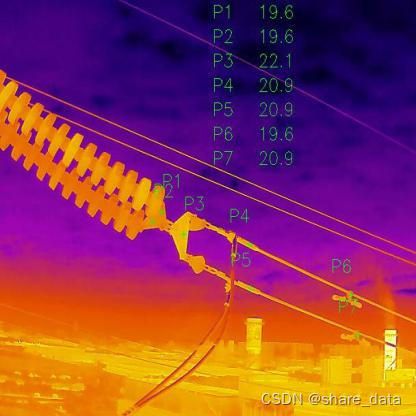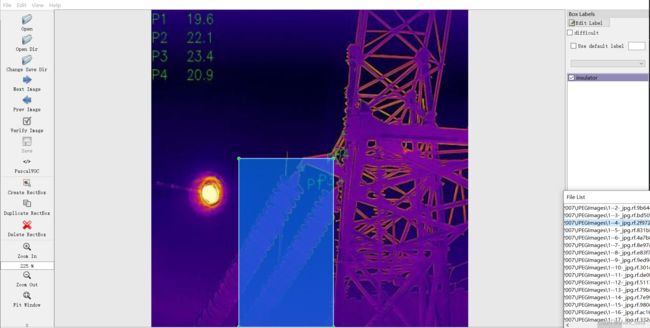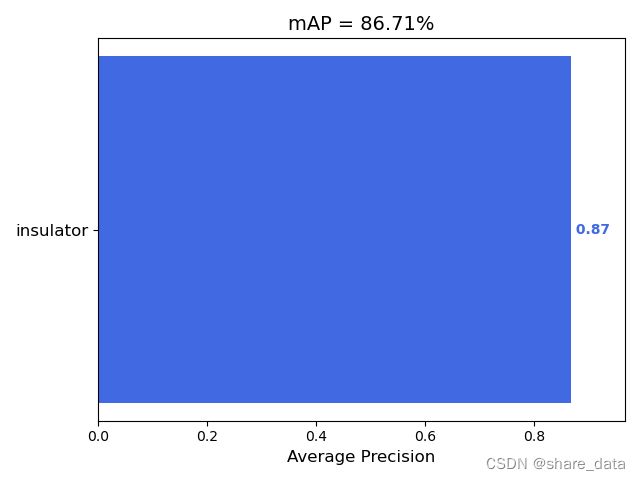绝缘子红外图像检测项目(TF2)
目录
1. 项目背景
2. 图像数据集介绍
labelimg的安装流程:
1. 打开Anaconda Prompt(Anaconda3)
2. 创建一个新环境来安装labelimg
3. 激活新创建的环境labelimg
4.输入
5.输入labelimg 即可运行
3. 模型介绍
4. 模型性能测试
1. 项目背景
瓷绝缘子在长期机电负荷与恶劣气候条件影响下,易发生劣化并出现零值现象,导致绝缘子串的有效爬电距离缩短,在过电压下易发生闪络击穿,严重威胁输配电线路的安全运行。红外热像法因其非接触式、安全高效的优点,成为现有技术中相对可行的零值绝缘子带电检测方法。
2. 图像数据集介绍
收集到440幅绝缘子红外测温图像,并利用labelimg对其中的绝缘子进行标注。
绝缘子VOC标签的格式如下:
1.jpg
1.jpg
roboflow.ai
416
416
3
0
labelimg的安装流程:
1. 打开Anaconda Prompt(Anaconda3)
2. 创建一个新环境来安装labelimg
conda create -n labelimg python=3.73. 激活新创建的环境labelimg
conda activate labelimg4.输入
conda activate labelimg5.输入labelimg 即可运行
3. 模型介绍
模型训练过程中采用余弦退火衰减算法、并采用adam优化完成对模型权值参数的更新,其中训练集:测试集=9:1,冻结原始预训练YOLOv5模型前234层,迭代训练800个epoch,batchsize1=8,再解冻迭代训练200个epoch,batchsize2=4,3060ti显卡。
主干特征提取网络:
from functools import wraps
import tensorflow as tf
from tensorflow.keras import backend as K
from tensorflow.keras.initializers import RandomNormal
from tensorflow.keras.layers import (Add, BatchNormalization, Concatenate,
Conv2D, Layer, MaxPooling2D,
ZeroPadding2D)
from tensorflow.keras.regularizers import l2
from utils.utils import compose
class SiLU(Layer):
def __init__(self, **kwargs):
super(SiLU, self).__init__(**kwargs)
self.supports_masking = True
def call(self, inputs):
return inputs * K.sigmoid(inputs)
def get_config(self):
config = super(SiLU, self).get_config()
return config
def compute_output_shape(self, input_shape):
return input_shape
class Focus(Layer):
def __init__(self):
super(Focus, self).__init__()
def compute_output_shape(self, input_shape):
return (input_shape[0], input_shape[1] // 2 if input_shape[1] != None else input_shape[1], input_shape[2] // 2 if input_shape[2] != None else input_shape[2], input_shape[3] * 4)
def call(self, x):
return tf.concat(
[x[..., ::2, ::2, :],
x[..., 1::2, ::2, :],
x[..., ::2, 1::2, :],
x[..., 1::2, 1::2, :]],
axis=-1
)
@wraps(Conv2D)
def DarknetConv2D(*args, **kwargs):
darknet_conv_kwargs = {'kernel_initializer' : RandomNormal(stddev=0.02), 'kernel_regularizer' : l2(kwargs.get('weight_decay', 5e-4))}
darknet_conv_kwargs['padding'] = 'valid' if kwargs.get('strides')==(2, 2) else 'same'
try:
del kwargs['weight_decay']
except:
pass
darknet_conv_kwargs.update(kwargs)
return Conv2D(*args, **darknet_conv_kwargs)
#---------------------------------------------------#
# 卷积块 -> 卷积 + 标准化 + 激活函数
# DarknetConv2D + BatchNormalization + SiLU
#---------------------------------------------------#
def DarknetConv2D_BN_SiLU(*args, **kwargs):
no_bias_kwargs = {'use_bias': False}
no_bias_kwargs.update(kwargs)
if "name" in kwargs.keys():
no_bias_kwargs['name'] = kwargs['name'] + '.conv'
return compose(
DarknetConv2D(*args, **no_bias_kwargs),
BatchNormalization(momentum = 0.97, epsilon = 0.001, name = kwargs['name'] + '.bn'),
SiLU())
def Bottleneck(x, out_channels, shortcut=True, weight_decay=5e-4, name = ""):
y = compose(
DarknetConv2D_BN_SiLU(out_channels, (1, 1), weight_decay=weight_decay, name = name + '.cv1'),
DarknetConv2D_BN_SiLU(out_channels, (3, 3), weight_decay=weight_decay, name = name + '.cv2'))(x)
if shortcut:
y = Add()([x, y])
return y
def C3(x, num_filters, num_blocks, shortcut=True, expansion=0.5, weight_decay=5e-4, name=""):
hidden_channels = int(num_filters * expansion)
x_1 = DarknetConv2D_BN_SiLU(hidden_channels, (1, 1), weight_decay=weight_decay, name = name + '.cv1')(x)
x_2 = DarknetConv2D_BN_SiLU(hidden_channels, (1, 1), weight_decay=weight_decay, name = name + '.cv2')(x)
for i in range(num_blocks):
x_1 = Bottleneck(x_1, hidden_channels, shortcut=shortcut, weight_decay=weight_decay, name = name + '.m.' + str(i))
#----------------------------------------------------------------#
route = Concatenate()([x_1, x_2])
return DarknetConv2D_BN_SiLU(num_filters, (1, 1), weight_decay=weight_decay, name = name + '.cv3')(route)
def SPPBottleneck(x, out_channels, weight_decay=5e-4, name = ""):
x = DarknetConv2D_BN_SiLU(out_channels // 2, (1, 1), weight_decay=weight_decay, name = name + '.cv1')(x)
maxpool1 = MaxPooling2D(pool_size=(5, 5), strides=(1, 1), padding='same')(x)
maxpool2 = MaxPooling2D(pool_size=(9, 9), strides=(1, 1), padding='same')(x)
maxpool3 = MaxPooling2D(pool_size=(13, 13), strides=(1, 1), padding='same')(x)
x = Concatenate()([x, maxpool1, maxpool2, maxpool3])
x = DarknetConv2D_BN_SiLU(out_channels, (1, 1), weight_decay=weight_decay, name = name + '.cv2')(x)
return x
def resblock_body(x, num_filters, num_blocks, expansion=0.5, shortcut=True, last=False, weight_decay=5e-4, name = ""):
# 320, 320, 64 => 160, 160, 128
x = ZeroPadding2D(((1, 0),(1, 0)))(x)
x = DarknetConv2D_BN_SiLU(num_filters, (3, 3), strides = (2, 2), weight_decay=weight_decay, name = name + '.0')(x)
if last:
x = SPPBottleneck(x, num_filters, weight_decay=weight_decay, name = name + '.1')
return C3(x, num_filters, num_blocks, shortcut=shortcut, expansion=expansion, weight_decay=weight_decay, name = name + '.1' if not last else name + '.2')
def darknet_body(x, base_channels, base_depth, weight_decay=5e-4):
# 640, 640, 3 => 320, 320, 12
x = Focus()(x)
# 320, 320, 12 => 320, 320, 64
x = DarknetConv2D_BN_SiLU(base_channels, (3, 3), weight_decay=weight_decay, name = 'backbone.stem.conv')(x)
# 320, 320, 64 => 160, 160, 128
x = resblock_body(x, base_channels * 2, base_depth, weight_decay=weight_decay, name = 'backbone.dark2')
# 160, 160, 128 => 80, 80, 256
x = resblock_body(x, base_channels * 4, base_depth * 3, weight_decay=weight_decay, name = 'backbone.dark3')
feat1 = x
# 80, 80, 256 => 40, 40, 512
x = resblock_body(x, base_channels * 8, base_depth * 3, weight_decay=weight_decay, name = 'backbone.dark4')
feat2 = x
# 40, 40, 512 => 20, 20, 1024
x = resblock_body(x, base_channels * 16, base_depth, shortcut=False, last=True, weight_decay=weight_decay, name = 'backbone.dark5')
feat3 = x
return feat1,feat2,feat3yolov5模型:
from tensorflow.keras.layers import (Concatenate, Input, Lambda, UpSampling2D,
ZeroPadding2D)
from tensorflow.keras.models import Model
from nets.CSPdarknet import (C3, DarknetConv2D, DarknetConv2D_BN_SiLU,
darknet_body)
from nets.yolo_training import yolo_loss
#---------------------------------------------------#
def yolo_body(input_shape, anchors_mask, num_classes, phi, weight_decay=5e-4):
depth_dict = {'s' : 0.33, 'm' : 0.67, 'l' : 1.00, 'x' : 1.33,}
width_dict = {'s' : 0.50, 'm' : 0.75, 'l' : 1.00, 'x' : 1.25,}
dep_mul, wid_mul = depth_dict[phi], width_dict[phi]
base_channels = int(wid_mul * 64) # 64
base_depth = max(round(dep_mul * 3), 1) # 3
inputs = Input(input_shape)
feat1, feat2, feat3 = darknet_body(inputs, base_channels, base_depth, weight_decay)
P5 = DarknetConv2D_BN_SiLU(int(base_channels * 8), (1, 1), weight_decay=weight_decay, name = 'conv_for_feat3')(feat3)
P5_upsample = UpSampling2D()(P5)
P5_upsample = Concatenate(axis = -1)([P5_upsample, feat2])
P5_upsample = C3(P5_upsample, int(base_channels * 8), base_depth, shortcut = False, weight_decay=weight_decay, name = 'conv3_for_upsample1')
P4 = DarknetConv2D_BN_SiLU(int(base_channels * 4), (1, 1), weight_decay=weight_decay, name = 'conv_for_feat2')(P5_upsample)
P4_upsample = UpSampling2D()(P4)
P4_upsample = Concatenate(axis = -1)([P4_upsample, feat1])
P3_out = C3(P4_upsample, int(base_channels * 4), base_depth, shortcut = False, weight_decay=weight_decay, name = 'conv3_for_upsample2')
P3_downsample = ZeroPadding2D(((1, 0),(1, 0)))(P3_out)
P3_downsample = DarknetConv2D_BN_SiLU(int(base_channels * 4), (3, 3), strides = (2, 2), weight_decay=weight_decay, name = 'down_sample1')(P3_downsample)
P3_downsample = Concatenate(axis = -1)([P3_downsample, P4])
P4_out = C3(P3_downsample, int(base_channels * 8), base_depth, shortcut = False, weight_decay=weight_decay, name = 'conv3_for_downsample1')
P4_downsample = ZeroPadding2D(((1, 0),(1, 0)))(P4_out)
P4_downsample = DarknetConv2D_BN_SiLU(int(base_channels * 8), (3, 3), strides = (2, 2), weight_decay=weight_decay, name = 'down_sample2')(P4_downsample)
P4_downsample = Concatenate(axis = -1)([P4_downsample, P5])
P5_out = C3(P4_downsample, int(base_channels * 16), base_depth, shortcut = False, weight_decay=weight_decay, name = 'conv3_for_downsample2')
out2 = DarknetConv2D(len(anchors_mask[2]) * (5 + num_classes), (1, 1), strides = (1, 1), weight_decay=weight_decay, name = 'yolo_head_P3')(P3_out)
out1 = DarknetConv2D(len(anchors_mask[1]) * (5 + num_classes), (1, 1), strides = (1, 1), weight_decay=weight_decay, name = 'yolo_head_P4')(P4_out)
out0 = DarknetConv2D(len(anchors_mask[0]) * (5 + num_classes), (1, 1), strides = (1, 1), weight_decay=weight_decay, name = 'yolo_head_P5')(P5_out)
return Model(inputs, [out0, out1, out2])
def get_train_model(model_body, input_shape, num_classes, anchors, anchors_mask, label_smoothing):
y_true = [Input(shape = (input_shape[0] // {0:32, 1:16, 2:8}[l], input_shape[1] // {0:32, 1:16, 2:8}[l], \
len(anchors_mask[l]), num_classes + 5)) for l in range(len(anchors_mask))]
model_loss = Lambda(
yolo_loss,
output_shape = (1, ),
name = 'yolo_loss',
arguments = {
'input_shape' : input_shape,
'anchors' : anchors,
'anchors_mask' : anchors_mask,
'num_classes' : num_classes,
'label_smoothing' : label_smoothing,
'balance' : [0.4, 1.0, 4],
'box_ratio' : 0.05,
'obj_ratio' : 1 * (input_shape[0] * input_shape[1]) / (640 ** 2),
'cls_ratio' : 0.5 * (num_classes / 80)
}
)([*model_body.output, *y_true])
model = Model([model_body.input, *y_true], model_loss)
return model
4. 模型性能测试
模型测试的mAP值:
获取mAP的程序:
import os
import xml.etree.ElementTree as ET
import tensorflow as tf
from PIL import Image
from tqdm import tqdm
from utils.utils import get_classes
from utils.utils_map import get_coco_map, get_map
from yolo import YOLO
gpus = tf.config.experimental.list_physical_devices(device_type='GPU')
for gpu in gpus:
tf.config.experimental.set_memory_growth(gpu, True)
if __name__ == "__main__":
classes_path = 'data/defeat_name.txt'
MINOVERLAP = 0.5
VOCdevkit_path = 'VOCdevkit'
image_ids = open(os.path.join(VOCdevkit_path, "VOC2007/ImageSets/Main/test.txt")).read().strip().split()
if not os.path.exists(map_out_path):
os.makedirs(map_out_path)
if not os.path.exists(os.path.join(map_out_path, 'ground-truth')):
os.makedirs(os.path.join(map_out_path, 'ground-truth'))
if not os.path.exists(os.path.join(map_out_path, 'detection-results')):
os.makedirs(os.path.join(map_out_path, 'detection-results'))
if not os.path.exists(os.path.join(map_out_path, 'images-optional')):
os.makedirs(os.path.join(map_out_path, 'images-optional'))
class_names, _ = get_classes(classes_path)
if map_mode == 0 :
print("Load model.")
yolo = YOLO(confidence = 0.001, nms_iou = 0.5)
print("Load model done.")
print("Get predict result.")
for image_id in tqdm(image_ids):
image_path = os.path.join(VOCdevkit_path, "VOC2007/JPEGImages/"+image_id+".jpg")
image = Image.open(image_path)
if map_vis:
image.save(os.path.join(map_out_path, "images-optional/" + image_id + ".jpg"))
yolo.get_map_txt(image_id, image, class_names, map_out_path)
print("Get predict result done.")
实例预测:




